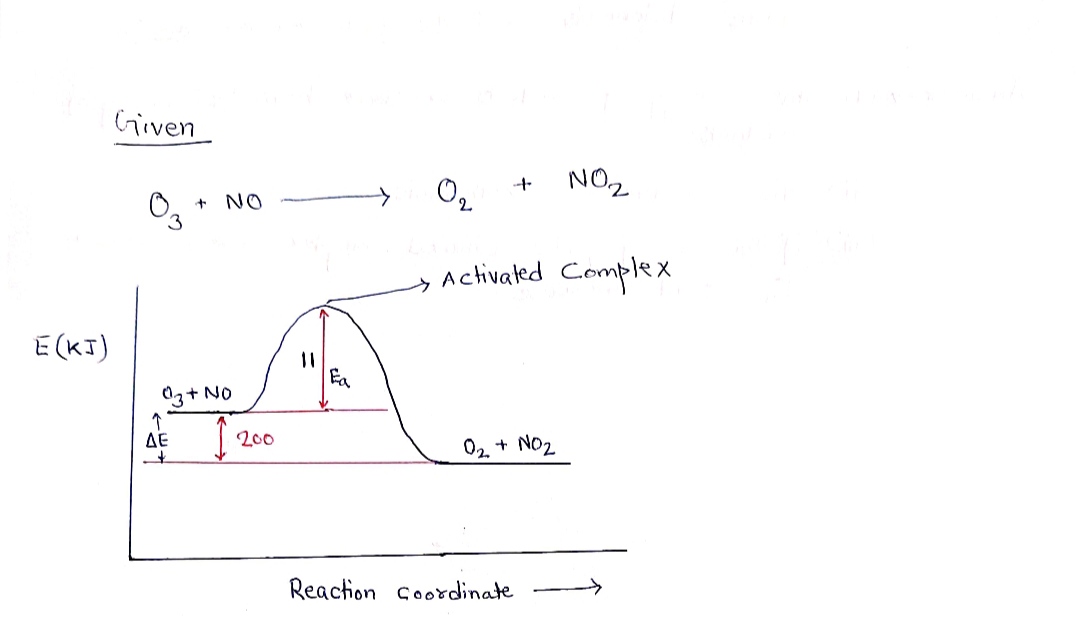A reaction profile (not to scale!) for the reaction 03 + NO O₂ + NO₂ is shown below: E (kJ) O3 + NO 200 Which of the following are true? Choose all that apply. 11 Reaction Coordinate O2 + NO2 The energy of the products is lower than the energy of the reactants. ✔AE is positive. The reaction is exothermic. If the energy of the activated complex were increased, Ea would increase.
A reaction profile (not to scale!) for the reaction 03 + NO O₂ + NO₂ is shown below: E (kJ) O3 + NO 200 Which of the following are true? Choose all that apply. 11 Reaction Coordinate O2 + NO2 The energy of the products is lower than the energy of the reactants. ✔AE is positive. The reaction is exothermic. If the energy of the activated complex were increased, Ea would increase.
Chemistry
10th Edition
ISBN:9781305957404
Author:Steven S. Zumdahl, Susan A. Zumdahl, Donald J. DeCoste
Publisher:Steven S. Zumdahl, Susan A. Zumdahl, Donald J. DeCoste
Chapter1: Chemical Foundations
Section: Chapter Questions
Problem 1RQ: Define and explain the differences between the following terms. a. law and theory b. theory and...
Related questions
Question
![**Reaction Profile for the Reaction \(\text{O}_3 + \text{NO} \rightarrow \text{O}_2 + \text{NO}_2\)**
This diagram illustrates the energy changes during the chemical reaction between ozone (\(\text{O}_3\)) and nitric oxide (\(\text{NO}\)) forming oxygen (\(\text{O}_2\)) and nitrogen dioxide (\(\text{NO}_2\)). The graph is not to scale.
**Graph Explanation:**
- **Y-Axis (E in kJ):** Represents the energy in kilojoules.
- **X-Axis (Reaction Coordinate):** Represents the progression of the reaction from reactants to products.
- **Curve:** Shows the energy pathway of the reaction.
**Energy Levels:**
- **Starting Energy (Reactants):** \(\text{O}_3 + \text{NO}\) has an energy level marked on the diagram.
- **Activation Energy (Ea):** The peak of the curve represents the energy of the activated complex, requiring an additional \(11 \, \text{kJ}\) above the reactants' energy.
- **Products Energy (O\(_2\) + NO\(_2\)):** The energy level of the products is lower than the reactants.
**Energy Change (ΔE):**
- \(200 \, \text{kJ}\) is the difference in energy from reactants to products, indicating that energy is released.
**Which of the following are true?** *(Choose all that apply.)*
- [ ] The energy of the products is **lower** than the energy of the reactants.
- [x] ΔE is **positive**.
- [x] The reaction is **exothermic**.
- [ ] If the energy of the activated complex were **increased**, Ea would **increase**.
This profile demonstrates that the reaction is exothermic, releasing more energy than initially absorbed, and the positive ΔE reflects the net energy release.](/v2/_next/image?url=https%3A%2F%2Fcontent.bartleby.com%2Fqna-images%2Fquestion%2F216d8975-823a-443e-8abc-06f056adfa09%2F93921a58-93c8-4566-b46c-98c905ef6ac0%2Fxz4bwz_processed.png&w=3840&q=75)
Transcribed Image Text:**Reaction Profile for the Reaction \(\text{O}_3 + \text{NO} \rightarrow \text{O}_2 + \text{NO}_2\)**
This diagram illustrates the energy changes during the chemical reaction between ozone (\(\text{O}_3\)) and nitric oxide (\(\text{NO}\)) forming oxygen (\(\text{O}_2\)) and nitrogen dioxide (\(\text{NO}_2\)). The graph is not to scale.
**Graph Explanation:**
- **Y-Axis (E in kJ):** Represents the energy in kilojoules.
- **X-Axis (Reaction Coordinate):** Represents the progression of the reaction from reactants to products.
- **Curve:** Shows the energy pathway of the reaction.
**Energy Levels:**
- **Starting Energy (Reactants):** \(\text{O}_3 + \text{NO}\) has an energy level marked on the diagram.
- **Activation Energy (Ea):** The peak of the curve represents the energy of the activated complex, requiring an additional \(11 \, \text{kJ}\) above the reactants' energy.
- **Products Energy (O\(_2\) + NO\(_2\)):** The energy level of the products is lower than the reactants.
**Energy Change (ΔE):**
- \(200 \, \text{kJ}\) is the difference in energy from reactants to products, indicating that energy is released.
**Which of the following are true?** *(Choose all that apply.)*
- [ ] The energy of the products is **lower** than the energy of the reactants.
- [x] ΔE is **positive**.
- [x] The reaction is **exothermic**.
- [ ] If the energy of the activated complex were **increased**, Ea would **increase**.
This profile demonstrates that the reaction is exothermic, releasing more energy than initially absorbed, and the positive ΔE reflects the net energy release.
Expert Solution
Step 1: Given parameters

Step by step
Solved in 3 steps with 3 images

Knowledge Booster
Learn more about
Need a deep-dive on the concept behind this application? Look no further. Learn more about this topic, chemistry and related others by exploring similar questions and additional content below.Recommended textbooks for you

Chemistry
Chemistry
ISBN:
9781305957404
Author:
Steven S. Zumdahl, Susan A. Zumdahl, Donald J. DeCoste
Publisher:
Cengage Learning

Chemistry
Chemistry
ISBN:
9781259911156
Author:
Raymond Chang Dr., Jason Overby Professor
Publisher:
McGraw-Hill Education

Principles of Instrumental Analysis
Chemistry
ISBN:
9781305577213
Author:
Douglas A. Skoog, F. James Holler, Stanley R. Crouch
Publisher:
Cengage Learning

Chemistry
Chemistry
ISBN:
9781305957404
Author:
Steven S. Zumdahl, Susan A. Zumdahl, Donald J. DeCoste
Publisher:
Cengage Learning

Chemistry
Chemistry
ISBN:
9781259911156
Author:
Raymond Chang Dr., Jason Overby Professor
Publisher:
McGraw-Hill Education

Principles of Instrumental Analysis
Chemistry
ISBN:
9781305577213
Author:
Douglas A. Skoog, F. James Holler, Stanley R. Crouch
Publisher:
Cengage Learning

Organic Chemistry
Chemistry
ISBN:
9780078021558
Author:
Janice Gorzynski Smith Dr.
Publisher:
McGraw-Hill Education

Chemistry: Principles and Reactions
Chemistry
ISBN:
9781305079373
Author:
William L. Masterton, Cecile N. Hurley
Publisher:
Cengage Learning

Elementary Principles of Chemical Processes, Bind…
Chemistry
ISBN:
9781118431221
Author:
Richard M. Felder, Ronald W. Rousseau, Lisa G. Bullard
Publisher:
WILEY